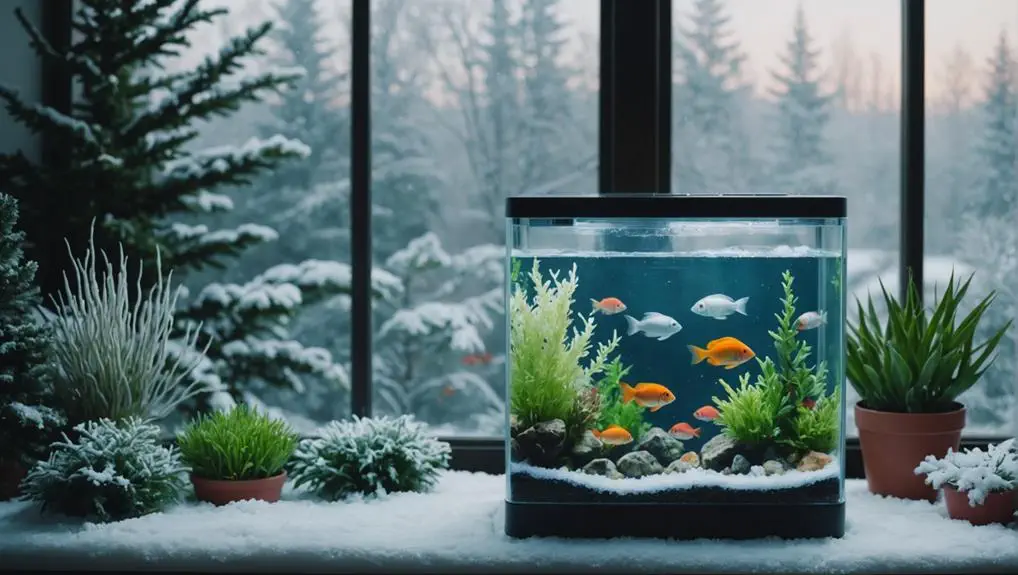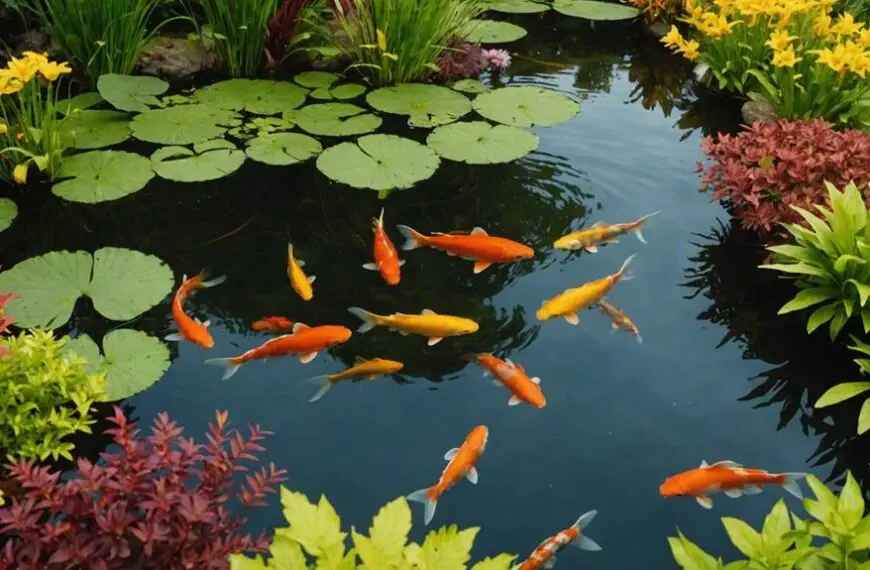To keep your fish tank happy during winter, focus on temperature control and feeding tweaks. Make sure your heater's working like a charm, aiming for 75-82°F. Feed your fish just once a day, since they tend to eat less when it's chilly. Don't forget to check your water quality regularly—nobody wants a fishy drama! Keep the tank away from drafts and windows to prevent temperature swings. And always watch your fish for signs of stress, like hiding or erratic swimming. Trust me, these simple steps will keep your underwater pals joyful and thriving. There's plenty more to explore!
Contents
- 1 Importance of Heaters
- 2 Winter Feeding Practices
- 3 Maintaining a Balanced Ecosystem
- 4 Protecting From External Weather
- 5 Monitoring Fish Health
- 6 Water Testing and Treatment
- 7 Aquarium Setup and Maintenance
- 8 Fish Selection and Acclimation
- 9 Common Mistakes to Avoid
- 10 General Winter Safety Tips
- 11 Frequently Asked Questions
- 12 Final Thoughts
Importance of Heaters
Heaters are crucial for maintaining a healthy environment in your fish tank. Since fish are ectothermic creatures, they rely on their surroundings to regulate their body temperature. An efficient heating system is essential to mimic their natural habitat, ensuring your fish stay comfortable and thrive.
Warmer water can reduce dissolved oxygen levels, which is vital for fish health, so maintaining an appropriate temperature is key to preventing stress and ensuring a stable ecosystem. You'll want to maintain water temperatures above 12°C, which can increase feeding frequency to 2-4 times a day. Who doesn't want happy, growing fish, right?
When you're choosing heaters, remember to size them correctly—aim for about 5 watts per gallon for tanks up to 55 gallons and 3 watts per gallon for larger tanks. This ensures sufficient heating, no matter how chilly it gets outside.
Plus, proper heater placement is key. Position it near your water circulation pump to facilitate even heat distribution. This way, you'll create a stable environment, minimizing stress for your fish.
Regularly check the temperature with a thermometer. Consistent monitoring helps prevent health issues that come from inadequate heating.
Winter Feeding Practices
As winter sets in, it's crucial to adjust your fish feeding practices to align with their natural behaviors. During these colder months, fish often slow down and eat less, so feeding them once a day is typically enough to support their health.
Regular water changes are also important during winter to maintain water quality and control nitrate levels, ensuring a healthy environment for your fish supports beneficial bacteria. Stick to a consistent feeding schedule to avoid sudden dietary changes that might stress your fish.
Keep a close eye on their behavior. If they seem lethargic or ignore their food, it could mean they don't need as much nourishment right now. Remember, overfeeding can lead to waste buildup and poor water quality, which no one wants in their tank! One well-portion meal a day is usually sufficient.
To keep the tank lively and healthy, consider offering a varied diet that includes frozen foods. These can pack a nutritious punch, helping your fish stay strong even in winter.
Maintaining a Balanced Ecosystem
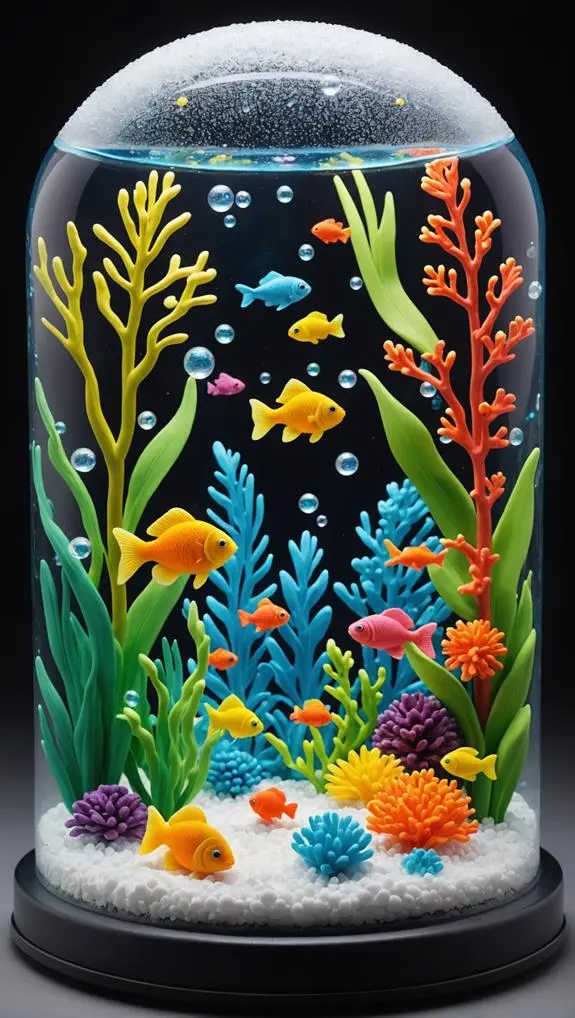
Keeping an eye on your fish can really tell you a lot about their environment. If they're swimming around happily, you're on the right track, but if they're just lounging like they're on a beach vacation, it might be time to check the water quality.
Regular tests for pH and ammonia levels can help keep things running smoothly, so your fish can thrive instead of just survive. Monitoring key water parameters like nitrite and nitrate levels is also essential to prevent stress and ensure a balanced ecosystem.
Observing Fish Behavior
Observing fish behavior is crucial for maintaining a balanced ecosystem in your tank. By watching your finned friends, you can spot signs of stress or health problems before they escalate.
When your fish swim actively and explore their environment, it usually means they're happy and healthy. However, if they become lethargic or hide away, it could be a sign that something's off.
Keep an eye on these key behaviors:
- Active swimming: Shows confidence and comfort.
- Schooling behavior: Indicates social interaction and well-being.
- Feeding response: Eager eaters are typically happy fish.
- Erratic swimming: May signal stress from poor conditions.
- Hiding: Could suggest health problems or discomfort.
Regularly observing these behaviors helps you maintain water quality and ensures your fish are thriving.
If you notice any odd patterns, it's time to step up your tank maintenance routine.
Remember, a balanced ecosystem isn't just about the water; it's about the fish too! By staying attentive, you'll create a lively, healthy environment where your fish can flourish.
After all, happy fish make for a happy tank owner!
Water Quality Checks
Maintaining a vibrant fish tank goes beyond simply watching your fish; it requires regular water quality checks to ensure a balanced ecosystem. A reliable water quality testing kit is your best friend here.
You'll want to check pH, ammonia, nitrite, and nitrate levels regularly to keep your aquatic buddies happy and healthy.
When it's cold outside, don't forget about tank maintenance in winter. Even during chilly months, fish can feel stressed if water conditions aren't ideal. Active fish behavior, like swimming around, indicates they're thriving, while lethargy might signal trouble.
Performing water changes of less than 25% helps avoid shocking your fish and destabilizing the ecosystem.
Also, keep an eye on algae growth — those little green invaders can lead to bigger problems if left unchecked.
Cleaning your filtration system is another essential task. It keeps contaminants at bay and ensures high water cleanliness.
Protecting From External Weather
Consistently protecting your aquarium from external weather is crucial during the winter months. Your fish depend on you to maintain a stable environment, and that means keeping an eye on those chilly drafts.
Start by sealing off any windows and vents near your tank; this'll help avoid abrupt temperature changes that could stress your aquatic friends.
Here are some tips to help you protect your setup:
- Ensure your heater is the right size for your tank.
- Maintain water temperatures between 24-28°C (75-82°F) for optimal fish comfort.
- Use insulating materials, like foam boards, to minimize heat loss.
- Monitor the temperature regularly, especially during power outages.
- Keep tank covers handy to prevent sudden drops in warmth.
Monitoring Fish Health
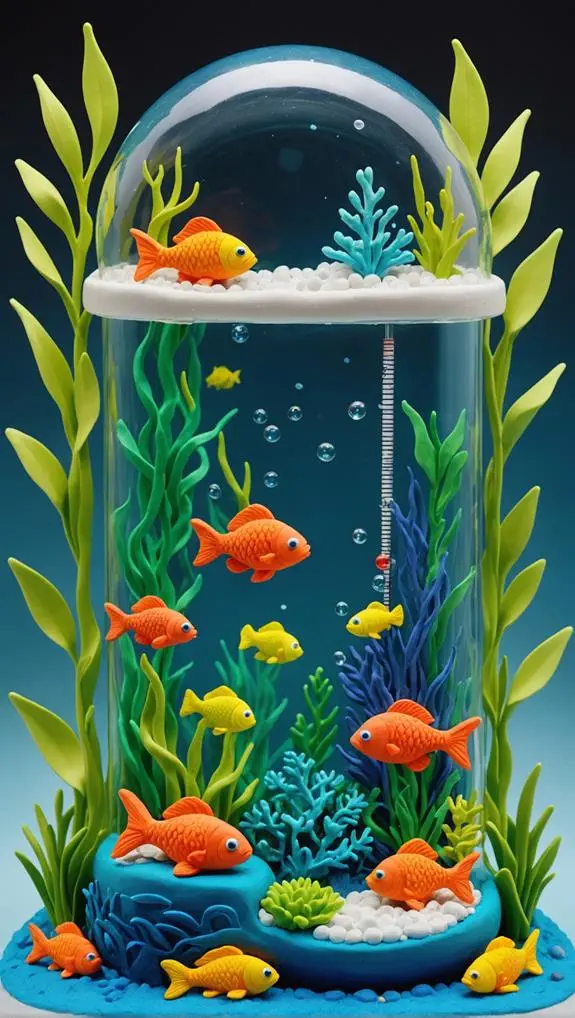
Keeping an eye on your fish is essential, especially during the chilly winter months.
You'll want to watch for any unusual behavior, like if they suddenly decide to play hide-and-seek a bit too much or start swimming like they're in a race.
Plus, checking for visible health signs can help you catch any issues early—because let's face it, a happy fish makes for a happy tank!
Observing Fish Behavior
How can you ensure your fish are thriving during the winter months? Observing fish behavior is key to maintaining a healthy environment for your aquatic animals.
Regularly check how your fish swim and interact. Active swimming shows they're happy, while lethargy might mean they're stressed or facing health problems.
Here are some tips to help you monitor their well-being:
- Watch for aggressive behavior or fish hiding; these can signal water quality issues.
- Keep an eye on their feeding responses; healthy fish generally can't wait for mealtime, while reluctance to eat could hint at problems.
- Inspect for visible signs of disease, like lesions or discoloration; catching these early can save your tank.
- Monitor water temperature to keep it stable between 24-28°C; fluctuations can stress your fish.
- Pay attention to changes in behavior, like erratic swimming or bottom-sitting; these could be signs of stress.
Identifying Health Symptoms
Monitoring your fish's health involves recognizing specific symptoms that indicate potential problems. Your fish tank ecosystem thrives best when you're attentive.
Start by regularly observing fish behavior; if they seem lethargic or just hanging out at the bottom, it could be a sign of stress or health problems.
Look for visible symptoms, too. Clamped fins, discoloration, or even lesions can indicate underlying issues that need your immediate attention.
Don't forget to check the temperature, as fluctuations can upset your aquatic friends.
Monitoring feeding habits is crucial; if your fish are suddenly refusing food, it might signal stress, illness, or environmental changes that need fixing.
Oh, and keep an eye out for signs of fungal disease. If you notice white spots or fuzzy growths, your fish may be feeling under the weather, particularly if they're already stressed.
Implement routine health checks, especially during feeding times. Catching issues early can save you a lot of heartache later.
Water Testing and Treatment
Before adding any water to your aquarium, it's essential to test it thoroughly for pH, alkalinity, nitrate, and phosphate levels to ensure a safe environment for your fish.
Using a reliable water testing kit makes this process straightforward and helps you keep your aquatic friends healthy.
Once you've tested the water, remember to use a water conditioner to neutralize harmful chlorine and ammonia found in tap water. Your fish deserve the best, after all!
Regular testing of your aquarium's water parameters is crucial, especially before introducing new fish. This helps prevent any health issues that could arise.
Here are a few key tips to keep in mind:
- Test your water parameters regularly.
- Acclimatize new fish gradually to avoid shock.
- Monitor the temperature regularly to prevent stress.
- Implement routine water changes of 10% weekly or 25% bi-weekly.
- Ensure replacement water matches the aquarium temperature.
Aquarium Setup and Maintenance
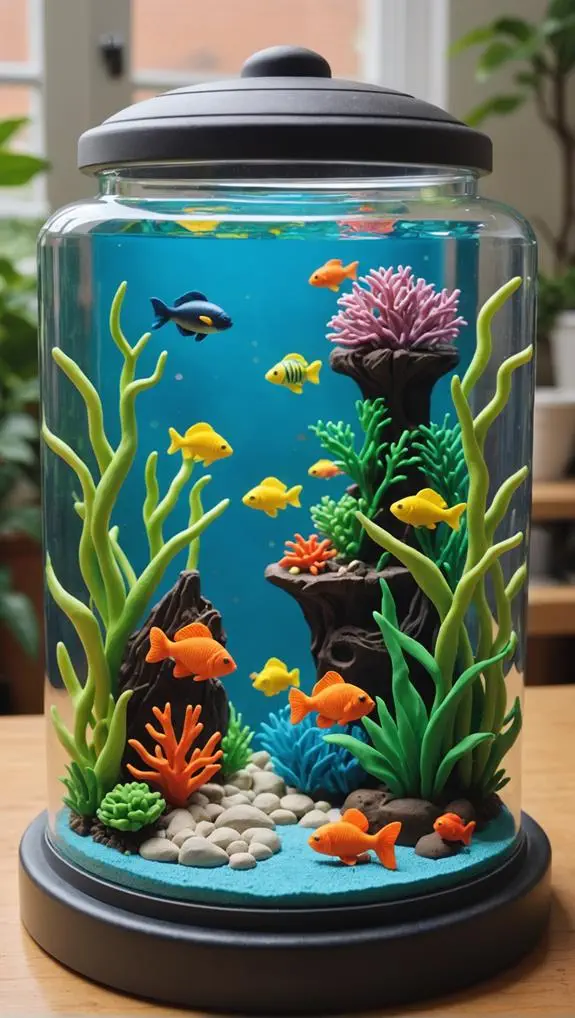
Setting up and maintaining your aquarium is essential for creating a thriving environment for your fish. When you first set up your tank, let it run for 2-3 days to establish a stable environment before introducing your fish. This gives the beneficial bacteria time to develop, ensuring your tank water is clean and safe.
Regular maintenance is key. Use a quality testing kit to check your water parameters, including pH and ammonia levels, before adding new fish. Change no more than 25% of the aquarium water at a time to keep the biological balance and reduce stress on your fish.
Remember to replace filter cartridges monthly and perform weekly inspections to keep everything running smoothly.
Don't forget the heater! Maintaining a consistent temperature is vital for your fish's well-being. If you're using tap water, make sure to add appropriate water conditioners to neutralize chlorine and ammonia before it enters the aquarium.
Fish Selection and Acclimation
When selecting fish for your aquarium, it's crucial to research species compatibility regularly. You want to create a harmonious environment that fosters healthy fish behavior.
Take time to consider factors like temperament and environmental needs.
Here are some key points to remember for a successful fish selection and acclimation process:
- Always purchase schooling fish in groups of 6 or more to reduce stress levels.
- Acclimate new fish by floating the bag in your tank for 15-30 minutes before introducing them.
- Gradually mix tank water into the bag to ease the transition.
- Avoid introducing new fish directly from store water; net them into your tank instead.
- Monitor new fish closely for at least a week to observe their behavior and ensure they adapt well.
Common Mistakes to Avoid
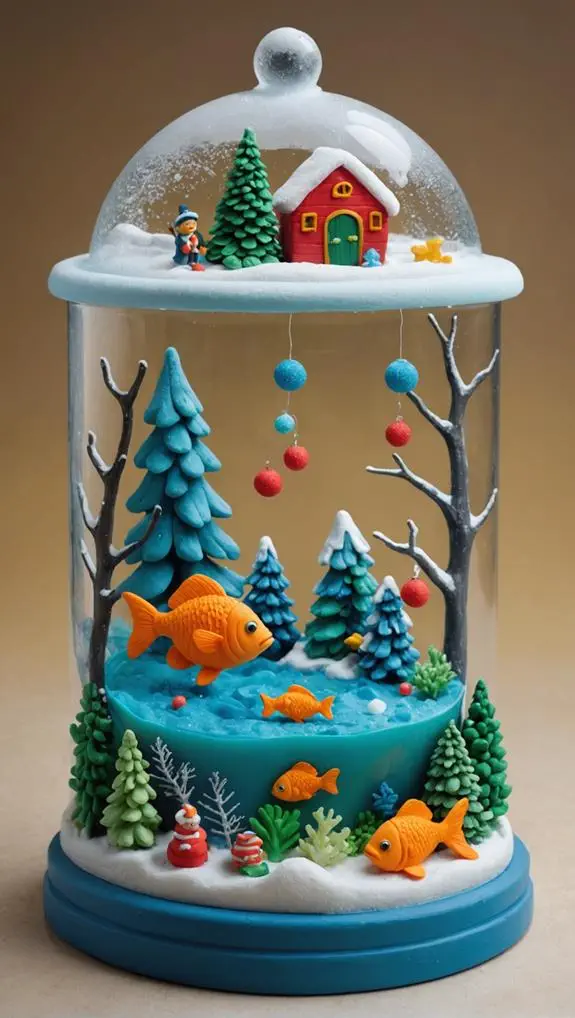
When it comes to winter care for your fish tank, there are some common mistakes you'll want to steer clear of.
Overfeeding can turn your underwater friends into little blimps, while improper equipment placement might leave them shivering in the cold.
Let's chat about how to keep your aquarium cozy and happy without the hiccups!
Overfeeding Issues
Many aquarium enthusiasts unknowingly contribute to overfeeding issues, which can have detrimental effects on their fish. Overfeeding leads to excess waste, degrading water quality and increasing health problems for your beloved aquarium fish.
To ensure your fish thrive this winter, keep these tips in mind:
- Limit feeding to what can be consumed in under 2 minutes.
- Offer a well-portioned meal once a day for optimal health.
- Monitor fish behavior during feeding—if they seem uninterested, you may be overfeeding.
- Rotate different food types to provide a balanced diet without overdoing it on any single source.
- Remove any uneaten food promptly to prevent stress and pollution.
Improper Equipment Placement
Proper equipment placement is crucial for maintaining a healthy aquarium environment during winter. When setting up your tank, make sure your heater isn't too close to decorations. If it is, you risk restricting water circulation, which can lead to uneven heating and stressed fish.
It's also wise to steer clear of placing your aquarium near windows or drafty areas. Those temperature fluctuations can throw your water conditions off, and your fish won't appreciate that!
Don't forget about your filtration system. If it's incorrectly installed, you might end up with dead spots where debris collects, affecting water quality.
And keep those thermometers away from heat sources! They can give you inaccurate readings, leading to improper temperature management within your tank.
Also, be cautious about overloading electrical outlets with multiple pieces of equipment. Winter months can be tough, and you don't want equipment failure on top of everything else.
General Winter Safety Tips
As winter sets in, ensuring the safety of your fish tank becomes crucial to keep your aquatic friends healthy and thriving.
With the cold months ahead, it's essential to take some proactive steps to control the internal temperature and maintain a balanced environment for your fish.
Here are some tips to help you out:
- Use tank covers to minimize heat loss and evaporation.
- Keep your aquarium away from drafty areas and windows to prevent any cold drafts.
- Regularly inspect your electrical setup to avoid overloads from increased winter usage.
- Ensure you have clear access to the tank for emergency maintenance; you never know when a crisis might arise!
- Plan for potential power outages with backup solutions like battery-operated air pumps.
Frequently Asked Questions
How Do You Take Care of a Fish Tank in the Winter?
To care for your fish tank in winter, ensure proper tank heating and water filtration, balance fish feeding, maintain substrate, control algae, manage tank lighting, and prioritize disease prevention to keep your aquatic friends healthy.
How Often Do You Change the Water in a Cold Water Fish Tank?
You should change the water in a cold water fish tank every week or bi-weekly. This helps with algae growth control, tank maintenance tips, and fish stress management, ensuring the fish thrive and the temperature remains stable.
How Cold Is Too Cold for Aquarium?
You need to know your fish species' temperature tolerance; generally, water below 20°C can stress them. Use aquarium heating, insulation methods, and proper heater placement to maintain stable water parameters during winter acclimation.
How Do I Keep My Fish Tank Fresh Water Healthy?
To keep your fish tank's freshwater healthy, regularly monitor water parameters, ensure fish compatibility, maintain tank filtration, control algae, adjust feeding routines, and implement seasonal adjustments for disease prevention. Your fish will thrive with your care!
Final Thoughts
So, as winter rolls in, don't forget your fish friends need a bit of extra care to stay healthy and happy. Have you ever thought about how cozy your tank can be? By keeping an eye on their environment, feeding habits, and overall health, you're ensuring a thriving aquarium. Remember, a little preparation goes a long way! Embrace these tips and enjoy the beauty of your tank all winter long—your fish will thank you with their vibrant colors!

